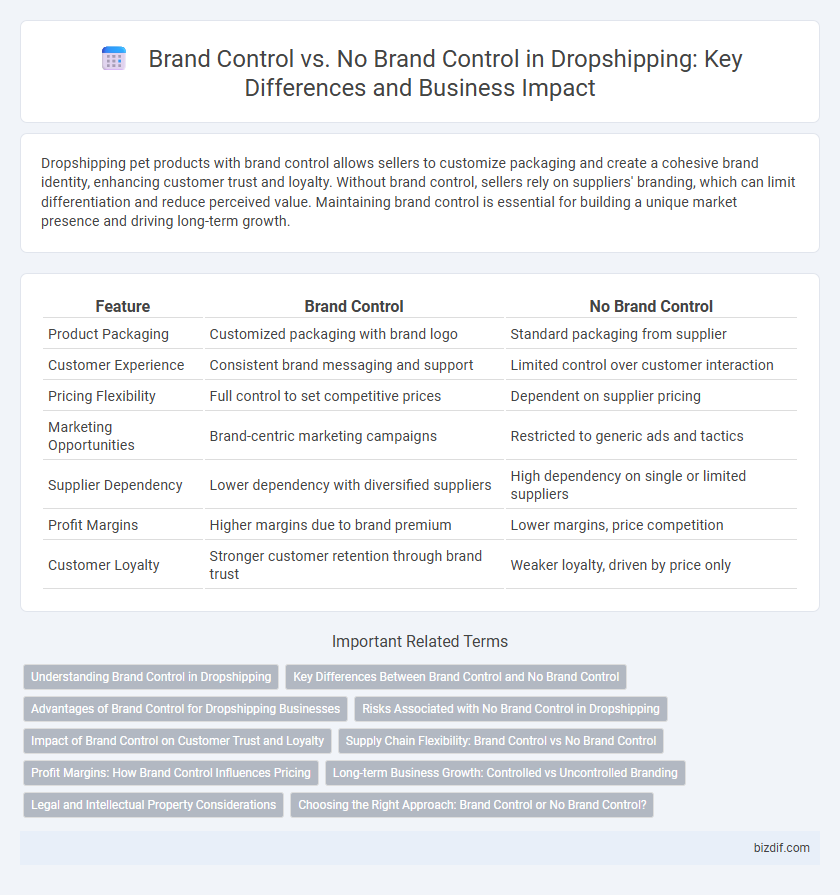Dropshipping pet products with brand control allows sellers to customize packaging and create a cohesive brand identity, enhancing customer trust and loyalty. Without brand control, sellers rely on suppliers' branding, which can limit differentiation and reduce perceived value. Maintaining brand control is essential for building a unique market presence and driving long-term growth.
Table of Comparison
| Feature | Brand Control | No Brand Control |
|---|---|---|
| Product Packaging | Customized packaging with brand logo | Standard packaging from supplier |
| Customer Experience | Consistent brand messaging and support | Limited control over customer interaction |
| Pricing Flexibility | Full control to set competitive prices | Dependent on supplier pricing |
| Marketing Opportunities | Brand-centric marketing campaigns | Restricted to generic ads and tactics |
| Supplier Dependency | Lower dependency with diversified suppliers | High dependency on single or limited suppliers |
| Profit Margins | Higher margins due to brand premium | Lower margins, price competition |
| Customer Loyalty | Stronger customer retention through brand trust | Weaker loyalty, driven by price only |
Understanding Brand Control in Dropshipping
Brand control in dropshipping refers to the level of influence a seller has over product presentation, packaging, and customer experience, which significantly impacts brand perception and customer loyalty. Without brand control, sellers rely heavily on suppliers' standards, limiting customization options and potentially diminishing brand uniqueness and trust. Understanding these dynamics helps dropshippers decide how much control they need to maintain a strong, differentiated brand presence in competitive markets.
Key Differences Between Brand Control and No Brand Control
Brand control in dropshipping allows sellers to customize packaging, establish a unique brand identity, and influence customer experience, leading to higher brand loyalty and perceived value. No brand control means sellers rely on suppliers' branding, resulting in limited differentiation and potentially lower customer retention. The key difference lies in the ability to create a consistent brand image versus operating as a generic reseller.
Advantages of Brand Control for Dropshipping Businesses
Brand control in dropshipping allows businesses to create a consistent customer experience by customizing packaging, marketing materials, and product quality, which enhances brand recognition and loyalty. This control enables higher profit margins through premium pricing and improved customer retention by fostering trust and credibility. By managing the brand identity, dropshipping businesses can differentiate themselves in a competitive market and build long-term customer relationships.
Risks Associated with No Brand Control in Dropshipping
No brand control in dropshipping exposes sellers to significant risks such as inconsistent product quality, delayed shipping times, and negative customer experiences that damage reputation and reduce repeat business. Without direct oversight, sellers cannot ensure packaging standards or prevent unauthorized use of their brand, leading to potential legal issues and diminished customer trust. These challenges underscore the critical importance of maintaining brand control to safeguard brand integrity and ensure long-term profitability in dropshipping operations.
Impact of Brand Control on Customer Trust and Loyalty
Maintaining brand control in dropshipping significantly enhances customer trust by ensuring consistent product quality, packaging, and messaging, which fosters loyalty and repeat purchases. Without brand control, customers may encounter variable experiences that diminish trust and increase the likelihood of negative reviews or returns. Strong brand control directly correlates with higher customer retention rates and improved lifetime value.
Supply Chain Flexibility: Brand Control vs No Brand Control
Supply chain flexibility in dropshipping significantly differs between brand control and no brand control scenarios, with brand control allowing retailers to manage supplier relationships, inventory standards, and shipping processes more directly. Without brand control, businesses rely heavily on suppliers' logistics, limiting their ability to quickly adapt to supply chain disruptions or customize the customer experience. Enhanced supply chain flexibility through brand control can lead to improved order fulfillment times and consistent product quality, crucial factors for maintaining customer satisfaction in competitive e-commerce markets.
Profit Margins: How Brand Control Influences Pricing
Brand control in dropshipping allows businesses to set premium prices by establishing a unique identity, directly enhancing profit margins through perceived value and customer trust. Without brand control, sellers compete mainly on price, leading to thinner margins due to commoditized products and easier price comparison. Effective brand control supports higher pricing strategies and improved profitability by differentiating products in saturated markets.
Long-term Business Growth: Controlled vs Uncontrolled Branding
Controlled branding in dropshipping allows for consistent brand messaging and customer experience, crucial for building trust and loyalty that drive long-term business growth. Uncontrolled branding often results in fragmented customer perceptions and weaker brand identity, limiting repeat purchases and repeat business opportunities. Investing in brand control enhances competitive advantage by establishing a recognizable and reputable market presence over time.
Legal and Intellectual Property Considerations
Brand control in dropshipping ensures legal compliance by allowing sellers to use their registered trademarks, protecting intellectual property rights and minimizing risks of infringement claims. Without brand control, sellers may face legal disputes due to unauthorized use of copyrighted images or trademarks, leading to account suspensions or penalties. Maintaining strict brand oversight helps secure product authenticity and enforce intellectual property laws, safeguarding the dropshipping business from costly legal liabilities.
Choosing the Right Approach: Brand Control or No Brand Control?
Choosing between brand control and no brand control in dropshipping hinges on your long-term business goals and customer experience priorities. Maintaining brand control allows for consistent messaging, stronger customer loyalty, and higher perceived value, while no brand control offers easier setup and lower upfront investment, often at the cost of diminished brand recognition. Evaluating factors such as marketing capability, product quality assurance, and scalability will guide the optimal approach for sustainable dropshipping success.
Brand Control vs No Brand Control Infographic

 bizdif.com
bizdif.com